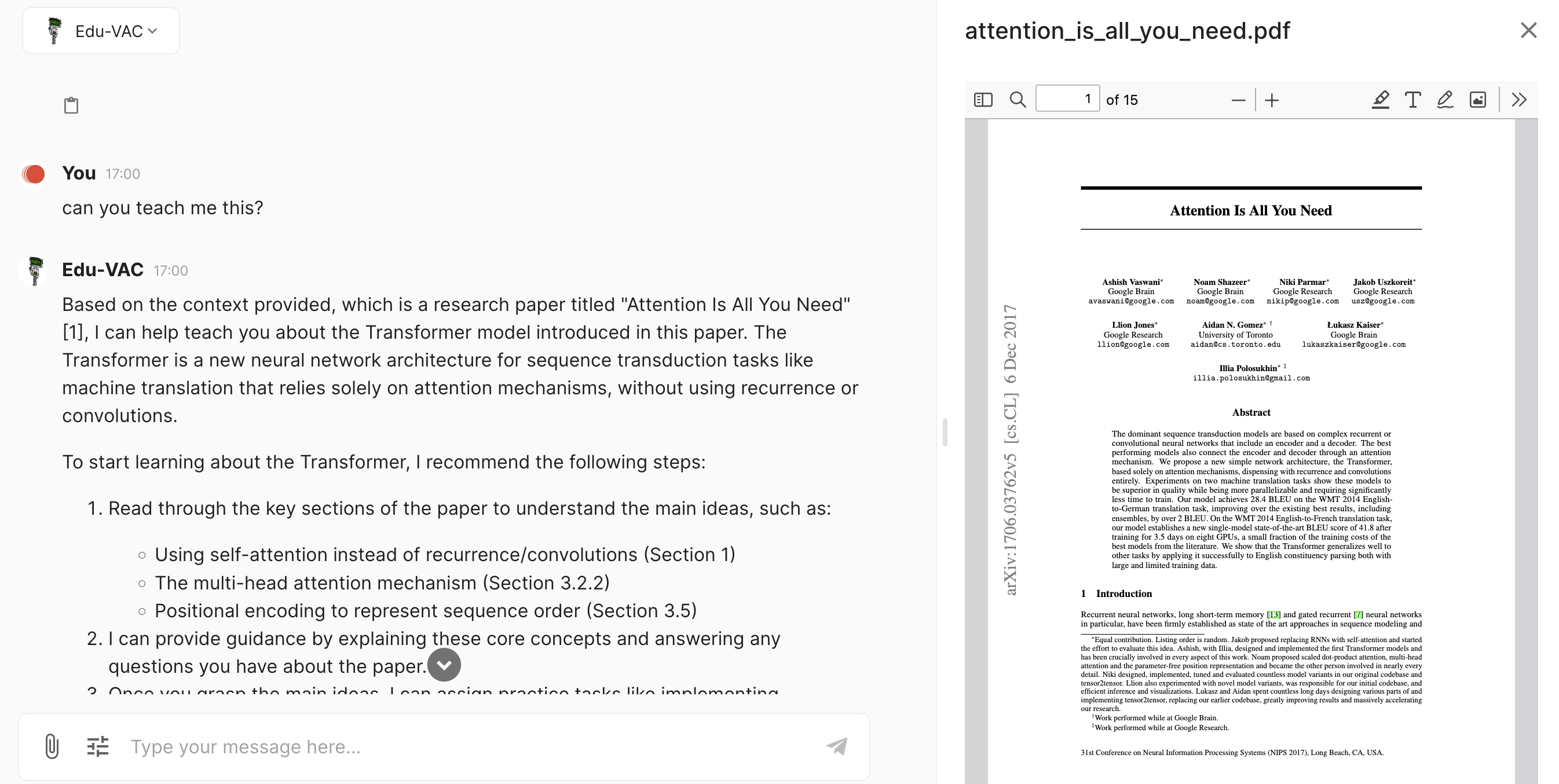EduVAC

This VAC is a Langserve app that allows users to interact via a database to learn specific material. It imports the data or allows users to upload their own files and get the bot to teach them using adaptive learning techniques, tailoring the lesson plan according to the student responses and previous experience.
Its code is open-source here: https://github.com/sunholo-data/vacs-public/tree/dev/eduvac

Summary
This VAC application incorporates the following features:
A Pydantic typed Question input schema:
class ChatEntry(BaseModel):
name: str
content: str
class Question(BaseModel):
question: str
chat_history: Optional[List[ChatEntry]] = []
source_filters: Optional[List[str]] = []
private_docs: Optional[List[str]] = []
source_filters_and_or: Optional[bool] = False
The sunholo functions within sunholo/agents/langserve.py query this input schema before sending it the payload to make sure it is in the correct format.
A configurable model
This allows the developer to set a choice for model to use, e.g. paid users can use a more expensive but smarter model
Using Langserve configurables within sunholo streaming functions such as generate_proxy_stream_async() you can configure Langserve attributes on the fly.
config_model = quick_model.configurable_alternatives(
ConfigurableField(
id="role",
name="User Role",
description=(
"The user role used to configure which model to use"
),
),
eduvac=model,
ADMIN=model,
USER=quick_model,
)
This is called from the Sunholo clients by adding a configurable parameter:
generate = await generate_proxy_stream_async
**kwargs,
# langchain configurable dictionary
configurable={
# if user role matches vector_name
"role": app_user.metadata["role"],
"vector_name": config["name"],
})
prompt including chat history, summary and pulled in document context
The main GenAI prompt uses these components to keep the conversation history relevant, and inserts the material that has been selected to learn within the client settings.
_inputs = RunnableParallel({
"metadata": RunnableLambda(get_retriever) | RunnableLambda(format_docs),
"question": itemgetter("question"),
"chat_history": RunnableLambda(format_chat_history) | itemgetter("chat_history"),
"chat_summary": RunnableLambda(format_chat_summary) | summary_branch | itemgetter("chat_summary"),
})
Retrieve from docstore
The initial implementation uses AlloyDB as its storage backend. It uses get_sources_from_docstore_async()[../sunholo/database/alloydb] to fetch sources based on the source_filters and source_filters_and_or arguments. You could replace this with any docstore.
Prompt management
The prompts themselves are managed by Langfuse, or a back up yaml file using the kind: promptConfig configuration.
GenAI analytics
The GenAI calls are sent to the Multivac Langfuse instance using the callback function provided via add_langfuse_tracing()
Config yaml
An explanation of the configuration is below:
vac.eduvac- this is the key that all other configurations are derived from, referred to as "vector_name"llm: The configuration specifies an LLM model. You can swap this for any model supported bysunholoso that it can work with theget_llm()function viamodel = get_llm("eduvac").agent: Required to specify what type of agent this VAC is, which determines which Cloud Run or other runtime is queried via the endpoints. This agent is derived from Langserve.agent_type: If the agent is not the same as theagent_typethen it is specified here to get the correct routing.display_name: Used by end clients such as the webapp for the UI.avatar_url: Used by end clients such as the webapp for the UI.description: Used by end clients such as the webapp for the UI.tags: Used to specify which users are authorized to see this VAC, defined viausers_config.yamlupload: This block determines if the user can upload file mime types and where they end up. For eduvac this is only available for users with the "eduvac" permission tag.buckets: Which Google Cloud Storage bucket uploads are availabledocstore: Whether the VAC has access to a docstore. Downloads entire documents after parsing.alloydb: For Eduvac, alloydb is used for chunking and the docstore. This configures connection.embedder: Configurations for embedding after chunking. In this case it specifies which LLM embedding model will be used.chunker: Configurations for chunking. When new documents are added to the bucket or uploaded, they will be automatically chunked according to the settings here. In this case, semantic chunking is used which uses an LLM to determine what are optimal chunk sizes.
kind: vacConfig
apiVersion: v1
vac:
eduvac:
llm: anthropic
model: claude-3-opus-20240229
agent: eduvac # needs to match cloud run service name
agent_type: langserve
display_name: Edu-VAC
tags: ["eduvac", "free"]
avatar_url: ../public/eduvac_small.png
description: "Educate yourself in your own personal documents via guided learning from Eduvac, the ever patient teacher bot. Use the settings below  to examine and select available syllabus. If you'd like to learn from your own private documents, get in touch at multivac@sunholo.com. "
upload:
mime_types:
- all
buckets:
all: multivac-eduvac-bucket
buckets:
raw: multivac-eduvac-bucket
docstore:
- alloydb-docstore:
type: alloydb
alloydb_config:
project_id: multivac-alloydb
region: europe-west1
cluster: multivac-alloydb-cluster
instance: primary-instance-1
embedder:
llm: openai # if different from llm is what embedding model uses
chunker:
type: semantic
llm: openai
summarise:
llm: openai
model: gpt-3.5-turbo
threshold: 3000
model_limit: 30000
